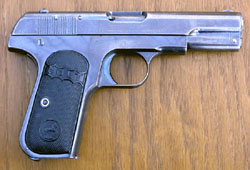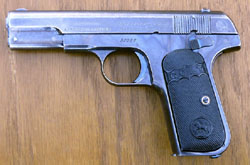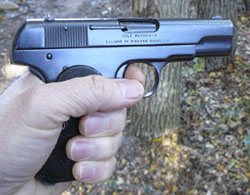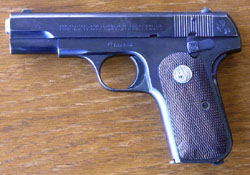|
The 1903/1908 Colt “Hammerless”
Pocket Model
by Ed Buffaloe
On 24 July 1896 John Moses Browning and Matthew S. Browning entered into an agreement with The Colt’s Patent Firearms Manufacturing Company. The agreement gave Colt’s the exclusive right to
manufacture John M. Browning’s pistol designs in the United States and market them in the United States, Great Britain, and Ireland. On 7 July 1897 John M. Browning and Fabrique Nationale (FN) signed a similar
agreement giving FN the right to sell Browning-designed weapons in much of Europe, and specifically excluding them from markets in the United States, Great Britain, and Ireland. According to Donald Bady, tacit in these
agreements was the understanding that Colt’s would manufacture Browning’s locked-breech recoil-operated designs and FN would manufacture the unlocked-breech “blowback” designs.
So it was that FN manufactured the 1899/1900 FN Browning in .32 caliber, and the following year Colt’s began to manufacture the Colt Automatic Pistol in .38 caliber. The FN was a stunning commercial success, with a production record of 100,000 pistols within three years and a total production of 724,450 over twelve years. By contrast, the original 1900 Colt Automatic Pistol had a total production run of less than 5000.
As early as 1901 FN was anxious to put a larger military pistol on the market. FN designed a 9mm cartridge which became known as the 9mm Browning Long. It was nothing more than a scaled-up 7.65mm
Browning (.32 A.C.P), with the same straight case and semi-rimmed design. FN asked Browning to design a gun for it. Browning, who was in his prime, delivered a prototype of the pistol to the FN factory in Herstal,
Belgium in February 1902, and FN engineers immediately began improving the design and readying it for production. Because of its larger size, it became known as the “Grande Modèle.”
 At this point, Colt’s was looking for an automatic pistol that would have the kind of commercial success that the 1900 FN
Browning had had, and despite its blowback action they asked Browning to patent his FN design in the U.S. and allow them to manufacture it in .32 caliber. Browning cut a deal with Colt’s to
make at least 100 guns per day and sell them at a price that would be competitive with revolvers in the U.S., as well as give him a 40 cent royalty on every gun produced. He modified the design of
the barrel bushing for the U.S. patent, which was filed on 3 April 1902 and granted on 22 December 1903 (№747,585), but that was the only design change he made for the U.S. version.
Colt’s did not wait for the patent to be granted, but began tooling up late in 1902, and began production of what they called the “Colt Automatic Pistol, Pocket Model” in June 1903.
Commercial sales began in August. To avoid confusion with its .38 caliber pocket model, Colt also referred to it as the Colt Hammerless Pocket Model, though it is not a true hammerless design.
The internal factory designation for the gun was Model M. The 1903 Colt Pocket Model was considerably smaller than the 1903 FN Grande Modèle (which did not go into full production until 1907). At this point, Colt’s was looking for an automatic pistol that would have the kind of commercial success that the 1900 FN
Browning had had, and despite its blowback action they asked Browning to patent his FN design in the U.S. and allow them to manufacture it in .32 caliber. Browning cut a deal with Colt’s to
make at least 100 guns per day and sell them at a price that would be competitive with revolvers in the U.S., as well as give him a 40 cent royalty on every gun produced. He modified the design of
the barrel bushing for the U.S. patent, which was filed on 3 April 1902 and granted on 22 December 1903 (№747,585), but that was the only design change he made for the U.S. version.
Colt’s did not wait for the patent to be granted, but began tooling up late in 1902, and began production of what they called the “Colt Automatic Pistol, Pocket Model” in June 1903.
Commercial sales began in August. To avoid confusion with its .38 caliber pocket model, Colt also referred to it as the Colt Hammerless Pocket Model, though it is not a true hammerless design.
The internal factory designation for the gun was Model M. The 1903 Colt Pocket Model was considerably smaller than the 1903 FN Grande Modèle (which did not go into full production until 1907).
 The hallmark of the 1903 design was its simplicity, which helped make it the most copied pistol in the world. The only feature that
might possibly be considered complex or extraneous was the grip safety, which most imitators omitted, but the 1903 was one of the first guns ever manufactured with a grip safety. I suspect that
military feedback on the 1900 Colt Automatic Pistol had influenced Browning’s design philosophy. Having grown up in a gun shop, firearms safety required little thought for him, but he
must eventually have realized that it was not so for everyone and he needed to make his pistols as safe as possible. The gun could also be disassembled without tools, which was another military preference. The hallmark of the 1903 design was its simplicity, which helped make it the most copied pistol in the world. The only feature that
might possibly be considered complex or extraneous was the grip safety, which most imitators omitted, but the 1903 was one of the first guns ever manufactured with a grip safety. I suspect that
military feedback on the 1900 Colt Automatic Pistol had influenced Browning’s design philosophy. Having grown up in a gun shop, firearms safety required little thought for him, but he
must eventually have realized that it was not so for everyone and he needed to make his pistols as safe as possible. The gun could also be disassembled without tools, which was another military preference.
The Model 1903 had the recoil spring beneath the barrel. The barrel was firmly secured to the receiver by a series of lugs on the underside which mated with slots in the receiver. The sear,
disconnector, hammer, and all springs were mounted in the receiver behind the magazine well, as was the grip safety. The magazine held 8 rounds. The quality of workmanship and finish on the
early versions of this gun were the finest in the world at the time. The guns were heat blued and polished with oil-soaked leather. The trigger and manual safety lever were given a brilliant fire blue.
In 1908 Colt began production of a .380 version of the gun. It differed only in the bore of the barrel, the width of the extractor, and the width of the magazine well. The .380 version could
easily be converted to .32, but not vice versa.
Over the 44 years of production (1903-1946) there were four or five major variants of the .32 Pocket Model and numerous sub- variants (not all of which will be described here).
 Type I: Serial numbers from 1 to 71,999. The first variant had a four inch barrel, a separate barrel bushing similar to
the one eventually used on the 1911 Government Model .45, no magazine safety, and 14 square cut “plunge milled” slide serrations that tapered toward the bottom. It featured
checkered hard rubber grips with “COLT” in a scalloped band inset at the top and the rampant colt logo in a circle at the bottom. The front sight was a tapered half-moon, and the
rear sight had a U-shaped notch. At approximately serial number 8000, a screw was added to the right side of the gun to retain the safety. At approximately serial number 25,000, the gun
was given 17 triangular-cut slide serrations. The original takedown arrow on the right side of the slide had four feather lines. At approximately serial number 55,000 a fifth feather line
was added. The first 10,000 or so pistols featured only the Apr. 20, 1897 patent date, after which the Dec. 22, 1903 patent date was added. The earliest guns were marked
“BROWNING’S PATENT”, per Browning’s agreement with Colt’s, but at some point Browning released Colt’s from this requirement and the guns were simply marked
“PATENTED”, beneath which were the patent dates. These earliest guns had the rampant Colt logo in a circle at the rear of the slide, just behind the slide serrations. Type I: Serial numbers from 1 to 71,999. The first variant had a four inch barrel, a separate barrel bushing similar to
the one eventually used on the 1911 Government Model .45, no magazine safety, and 14 square cut “plunge milled” slide serrations that tapered toward the bottom. It featured
checkered hard rubber grips with “COLT” in a scalloped band inset at the top and the rampant colt logo in a circle at the bottom. The front sight was a tapered half-moon, and the
rear sight had a U-shaped notch. At approximately serial number 8000, a screw was added to the right side of the gun to retain the safety. At approximately serial number 25,000, the gun
was given 17 triangular-cut slide serrations. The original takedown arrow on the right side of the slide had four feather lines. At approximately serial number 55,000 a fifth feather line
was added. The first 10,000 or so pistols featured only the Apr. 20, 1897 patent date, after which the Dec. 22, 1903 patent date was added. The earliest guns were marked
“BROWNING’S PATENT”, per Browning’s agreement with Colt’s, but at some point Browning released Colt’s from this requirement and the guns were simply marked
“PATENTED”, beneath which were the patent dates. These earliest guns had the rampant Colt logo in a circle at the rear of the slide, just behind the slide serrations. - Type II: Serial numbers from 72,000 to 105,050. This variant differed from the first only in
that it had the barrel reduced in length to three-and-three-quarter inches. I’ve never been able to determine a reason for this reduction in barrel length. Serial numbers 72,000 to 74,500
had no take-down arrow, due to the reduced slide length, but subsequent guns had a very short arrow with no feather lines. In 1908 the .380 version was introduced, and its serial numbers
began with 1. Beginning with serial number 95,801, the extractor on the .32 version was widened to handle both .32 and .380 cartridges. In 1912 the circle was removed from the rampant Colt logo on the slide.
- Type III: Serial numbers from 105,051 to 468,097 (6251 to 92,893 for the .380). The primary difference in this variant was the elimination of the barrel bushing. A lug was added
to the bottom front end of the barrel to keep it locked in position. At approximately serial number 114,700 the screw that retained the safety was eliminated. At some point, the slide
cutout into which the barrel rotated was machined further to the rear, so the slide did not have to be retracted as far to disassemble the gun, and the takedown arrow was lengthened.
However, feather marks were not added. About 1911 (at approximately serial number 115,000 for the .32 and 8000 for the .380) the scalloped band around the word “COLT” was
eliminated in favor of two straight
 lines, and an elongated letter “C” appeared behind the rampant colt instead of the circle. In about 1913 (at
approximately serial number 160,000 for the .32 and 16,000 for the .380) the elongated “C” behind the colt was eliminated. In 1915 (at approximately serial number 190
,000 for the .32 and 23,500 for the .380) a step was machined in the side of the lower curved portion of the slide. In 1919 Colt began striking the last four digits of the serial
number on the underside of the breech block. By the end of the year they were striking the entire serial number in the
same location. In 1920 the front sight was changed to a squared post. In 1921 the curvature of the top surface of the slide was changed give slightly more room on the two flat sides. In
1922 the hammer design was changed to give it a half-cock position, in which the manual safety could be engaged. Prior to this time, the hammer had to be fully cocked in order to
engage the manual safety. In 1924 Colt began using checkered walnut grips with a Colt medallion (these grips may have been available earlier as a special order). The very earliest
guns had a different medallion for each side, so that the colt faced forward on both sides, but by the end of 1926 they were using the same medallion on both sides, so the colt always faced
to the left. There are a number of early minor variations of the checkered wooden grips. In 1926 the rear sight notch was made square. lines, and an elongated letter “C” appeared behind the rampant colt instead of the circle. In about 1913 (at
approximately serial number 160,000 for the .32 and 16,000 for the .380) the elongated “C” behind the colt was eliminated. In 1915 (at approximately serial number 190
,000 for the .32 and 23,500 for the .380) a step was machined in the side of the lower curved portion of the slide. In 1919 Colt began striking the last four digits of the serial
number on the underside of the breech block. By the end of the year they were striking the entire serial number in the
same location. In 1920 the front sight was changed to a squared post. In 1921 the curvature of the top surface of the slide was changed give slightly more room on the two flat sides. In
1922 the hammer design was changed to give it a half-cock position, in which the manual safety could be engaged. Prior to this time, the hammer had to be fully cocked in order to
engage the manual safety. In 1924 Colt began using checkered walnut grips with a Colt medallion (these grips may have been available earlier as a special order). The very earliest
guns had a different medallion for each side, so that the colt faced forward on both sides, but by the end of 1926 they were using the same medallion on both sides, so the colt always faced
to the left. There are a number of early minor variations of the checkered wooden grips. In 1926 the rear sight notch was made square.
- Type IV: Serial numbers from 468,098 to 554,099 (92,894 to 134,099 for the .380). The Tansley magazine disconnect safety was added at the end of 1926 to make this variant.

- Type V: Serial numbers from 554,100 to 568,834 (134,100 to 137,484 for the .380). These were war production guns, which would be indistinguishable from the Type IV guns,
except the vast majority had a Parkerized finish (from about serial number 562,000) and were stamped “U.S. Property” on the right side of the frame. They also had a flaming bomb
acceptance mark stamped on them by the U.S. Ordnance Department, and were given an “M” prefix to the serial number. In 1944 the number of slide serrations was increased to 19, the rear sight profile
was made more square and less rounded, and the front sight was serrated on its back surface.
Manufacture of the Models 1903 and 1908 ceased in 1945, but they continued to be assembled from existing parts until 1953.
Over the 44 years of manufacture, a number of Model 1903 and 1908 Colts were purchased for military and police use, some of which were given special markings.
- Around 1905 the Woonsocket Police of Rhode Island purchased an unknown quantity of .32 pocket models in the vicinity of serial number 18,020, which were marked “WPD.”
- Around 1913 the New York Police Department purchased an unknown quantity of .380 pocket models in the vicinity of serial number 15,900, which were marked “PDNY” and also
given a separate serial number.
- In 1915 the Belgian Army placed an order for 24,002 pistols in .32 caliber. These guns were struck with an “A” inside a diamond to the right of the serial number. Most of these guns
were also stamped on the barrel, slide, and frame with a Belgian military acceptance mark consisting of a crowned oval surrounding the letters “EGB”.
- In 1917 the United States Navy purchased 200 .32 caliber pocket models with serial numbers between 227,226 and 260,924. I do not know if they received any special markings.
- An unknown quantity of .32 caliber pocket models were sold to Great Britain during World War I. Most (but possibly not all) were stamped with crown over “V” and crown over “GP”
proof marks on the slide, frame, and barrel.
- In World War II, approximately 7973 .32 caliber pocket models and 400 .380 caliber pocket models were sold to Great Britain.
- In 1942 an unknown number of .380 caliber pocket models in the vicinity of serial number 134,500 were sold to the British Purchasing Commission. These guns were marked “WAP”
and given an additional serial number.
- In 1942 an unknown number of .380 caliber pocket models in the vicinity of serial number 134,000 were sold to the French Concession in Shanghai. These guns had a lanyard ring, and
were given an additional serial number and marked “CONCESSION FRANCAISE CHANGHAI”.
Field Stripping
- Remove the magazine and clear the chamber.
- Depress the grip safety and and draw the slide back until the takedown arrow on the right side of the slide lines up with the front portion of the frame.
- Twist the barrel counterclockwise as you face the front of the gun, so the lugs on the bottom of the barrel turn up into the cut inside the slide, and draw the slide and barrel off the front of the gun.
- The barrel may be removed from the early guns (with barrel bushing) by turning the barrel back to its normal position and twisting the bushing a half turn, allowing both to be removed
from the front of the slide. The barrel may be removed from later guns by turning the barrel back to its normal position and withdrawing it from the front of the slide.
|
Serial Numbers by Year
|
|
Year
|
.32 Caliber
|
.380 Caliber
|
|
1903
|
1-4099
|
|
|
1904
|
4100-16499
|
|
|
1905
|
16500-33999
|
|
|
1906
|
34000-50999
|
|
|
1907
|
51000-67399
|
|
|
1908
|
67400-81799
|
1-2499
|
|
1909
|
81800-94429
|
2500-4389
|
|
1910
|
94430-106449
|
4390-6969
|
|
1911
|
106450-125524
|
6970-9749
|
|
1912
|
125525-141909
|
9750-12849
|
|
1913
|
141910-160739
|
12850-16874
|
|
1914
|
160740-176474
|
16875-20849
|
|
1915
|
176475-194674
|
20850-25324
|
|
1916
|
194675-235474
|
25325-30674
|
|
1917
|
235475-264699
|
30675-32999
|
|
1918
|
264700-283449
|
33000-34379
|
|
1919
|
283450-330924
|
34380-42124
|
|
1920
|
330925-377474
|
42125-53749
|
|
1921
|
377475-409699
|
53750-62899
|
|
1922
|
409700-426649
|
62900-69979
|
|
1923
|
426650-450149
|
69980-78779
|
|
1924
|
450150-457724
|
78780-82259
|
|
1925
|
457725-466699
|
82260-89274
|
|
1926
|
466700-480849
|
89275-95424
|
|
1927
|
480850-487999
|
95425-99349
|
|
1928
|
488000-492599
|
99340-94999
|
|
1929
|
492600-501159
|
95000-101824
|
|
1930
|
501160-506574
|
101825-107474
|
|
1931
|
506575-511524
|
107475-110359
|
|
1932
|
511525-513824
|
110360-113794
|
|
1933
|
513825-514399
|
113795-115934
|
|
1934
|
514400-517839
|
115935-117309
|
|
1935
|
517840-519324
|
117310-119859
|
|
1936
|
519325-522674
|
119860-121949
|
|
1937
|
522675-530124
|
121950-125124
|
|
1938
|
530125-538174
|
125125-128299
|
|
1939
|
538175-541324
|
128300-130984
|
|
1940
|
541325-545099
|
130985-132909
|
|
1941
|
545100-554099
|
132910-134099
|
|
1942
|
554100-558196
|
134100-134839
|
|
1943
|
|
|
|
1944
|
558197-568834
|
134840-137484
|
|
1945-1953
|
568835-572215
|
137485-138010
|
|
|
Markings on the 1903 Colt .32 Pocket Model
|
|
Year
|
Left Side of Slide
|
Right Side of Slide
|
|
1903
|
“BROWNING’S PATENT” COLT’S
PAT F.A. M’F’G. CO.
PAT’D APRIL.20.1897 HARTFORD. CONN.
U.S.A.
|
AUTOMATIC COLT
CALIBRE 32 RIMLESS SMOKELESS
|
|
1904
|
“BROWNING’S PATENT”
COLT’S PAT F.A. M’F’G. CO.
APR.20.1897 DEC.22.1903 HARTFORD. CONN. U.S.A.
|
AUTOMATIC COLT
CALIBRE 32 RIMLESS SMOKELESS
|
|
1906
|
PATENTED COLT’S PAT F.A. M’F’G. CO.
APR.20.1897 DEC.22.1903 HARTFORD. CONN. U.S.A.
|
AUTOMATIC COLT
CALIBRE 32 RIMLESS SMOKELESS
|
|
1910
|
PATENTED COLT’S PAT F.A. M’F’G. CO.
APR.20.1897 DEC.22.1903 HARTFORD. CT. U.S.A.
|
AUTOMATIC COLT
CALIBRE 32 RIMLESS SMOKELESS
|
|
1918?
|
COLT’S PT. F.A. MFG. CO. HARTFORD. CT. U.S.A.
PATENTED APR. 20. 1897 . DEC. 22. 1903
|
COLT AUTOMATIC
CALIBRE 32 RIMLESS SMOKELESS
|
|
Markings on the 1908 Colt .380 Pocket Model
|
|
1908
|
“BROWNING’S PATENT”
COLT’S PAT F.A. M’F’G. CO.
APR.20.1897 DEC.22.1903 HARTFORD. CONN. U.S.A.
|
AUTOMATIC COLT
CALIBRE 380 HAMMERLESS
|
|
1910
|
PATENTED COLT’S PAT F.A. M’F’G. CO.
APR.20.1897 DEC.22.1903 HARTFORD. CT. U.S.A.
|
AUTOMATIC COLT
CALIBRE 380 HAMMERLESS
|
|
1920
|
COLT’S PT. F.A. MFG. CO. HARTFORD. CT. U.S.A.
PATENTED APR. 20. 1897 . DEC. 22. 1903
|
COLT AUTOMATIC
CALIBRE 380 HAMMERLESS
|
|
A note about safety: You might think that the 1903 and 1908 Colt “Hammerless” pistols would
be considered safe guns to carry since they have both a grip safety and a manual safety. However, they do not have a firing-pin lock safety and are therefore not “drop safe”. The firing pin is
inertial, and if the gun is dropped hard enough and lands at the proper angle the firing pin can strike the cartridge with enough force to ignite the primer. There is at least one documented case
of an experienced shooter being killed by dropping a 1903 Colt. These guns should not be considered safe to carry with a round in the chamber.
|






